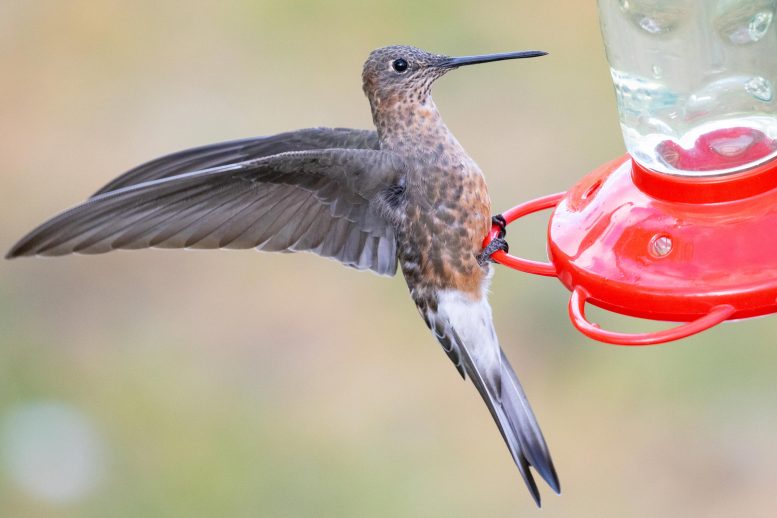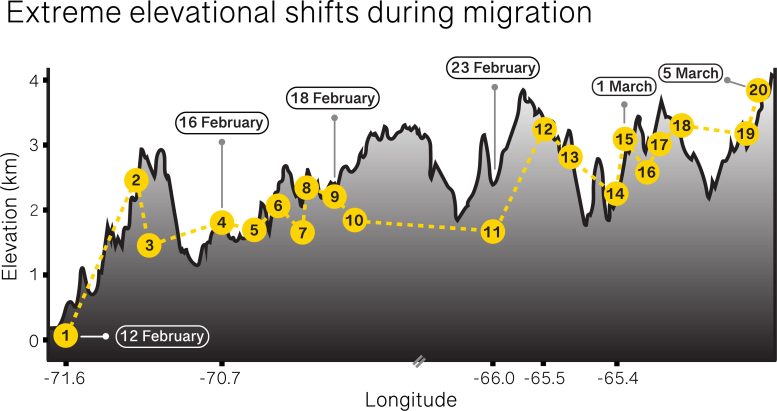
Measured against a typical nectar feeder, the size of a Giant Hummingbird is even more astonishing. Credit: © Xiaoni Xu | Macaulay Library | Cornell Lab of Ornithology
Researchers at the University of New Mexico have documented the extreme migration of giant hummingbirds, uncovering their journey over 13,000 feet to the high Andes and identifying a new species found “hiding in plain sight.”
The Giant Hummingbird, previously considered a single species in western South America, is actually two distinct species, according to recent research by an international team. The northern population resides in the high Andes throughout the year, whereas the southern population migrates from sea level to elevations as high as 14,000 feet during the nonbreeding months. The two species appear identical. But looks deceive—their genomes and behaviors reveal significant differences. The paper announcing the discovery was published in the journal Proceedings of the National Academy of Sciences.
“These are amazing birds,” said lead author Jessie Williamson, a National Science Foundation Postdoctoral Fellow and Rose Postdoctoral Fellow at the Cornell Lab of Ornithology. “They’re about eight times the size of a Ruby-throated Hummingbird. We knew that some Giant Hummingbirds migrated, but until we sequenced genomes from the two populations, we had never realized just how different they are.”
A Southern Giant Hummingbird takes flight with a geolocator backpack to track its migration. Credit: Jessie Williamson
Genetic and Behavioral Differences
“They are as different from each other as chimpanzees are from bonobos,” said senior author Chris Witt at the University of New Mexico. “The two species do overlap on their high elevation wintering grounds. It’s mind-boggling that until now nobody figured out the Giant Hummingbird mystery, yet these two species have been separate for millions of years. ”
At first, the research goal was simply to learn where the migratory population went—a journey tracked with geolocators and satellite transmitters. The researchers actually tracked 8 individual hummingbirds migrating up to 5,200 miles from the Chilean coast up to the Andes of Peru and back. Williamson says that’s one of the longest, if not the longest hummingbird migration in the world. The out-and-back journey is longer than the distance from New York City to Istanbul, Turkey.

Elevational ascent of a Giant Hummingbird, illustrated by high-resolution Argos satellite tracking data. During a period of 21 days, the bird showed bursts of ascent interspersed with pauses and even slight downward movements. The bird stopped at mid-elevations to acclimatize before ascending the high peaks of the Andes. Credit: Jessie Williamson.
Implications for Speciation and Conservation
The authors say the shift in migratory behavior is what drove speciation, though there’s no way to tell whether migratory behavior was gained by one species or lost by the other. Until now, there had been only one known species on this branch of the hummingbird family tree, while the Giant Hummingbird’s closest relatives––the world’s smallest hummingbirds––diversified into 165 distinct hummingbird species.
The researchers are proposing straightforward common names: Northern Giant Hummingbird and Southern Giant Hummingbird. The southern migrant species will retain the Latin name, Patagona gigas. The proposed scientific name for the resident northern population is Patagona chaski. “Chaski” is Quechua for “messenger.” Quechua is the name for a family of Indigenous languages that spread from Peru to other neighboring countries.
Community Engagement and Future Research
The researchers relied on support and local knowledge from landowners and villages in Peru and Chile. Co-author Emil Bautista’s village in Peru was a home base for this project and the community supported the scientists’ work. But even with more than 15 years of field experience, Bautista admits this fieldwork was the hardest he’s ever done.
“Capturing Giant Hummingbirds is very challenging,” he said. “They watch everything and they know their territories well. We had to be strategic in choosing sites for our nets. If Giant Hummingbirds see something unusual, they won’t visit that spot. They are more observant than other birds.”
Right now, Giant Hummingbird populations, north and south, are stable and the species are common within their ranges—some even visit backyard nectar feeders. The team plans to continue research on these enigmatic birds.
“We have to figure out where these two forms come together and how they interact,” said Witt. “Do they compete, is one dominant over the other, how might they partition resources, and do they mix or spatially segregate within the winter range? Lots of interesting questions to pursue!”
“I’m really interested in how Southern Giant Hummingbirds make such dramatic shifts in elevation during migration. They travel from sea level to the high Andes in just a few weeks,” said Williamson. “They’re like miniature mountain climbers. How do they change their physiology to facilitate these movements?”
For more on this discovery, see Miniature Backpacks Reveal New Giant Hummingbird Species.
Reference: “Extreme elevational migration spurred cryptic speciation in giant hummingbirds” by Jessie L. Williamson, Ethan F. Gyllenhaal, Selina M. Bauernfeind, Emil Bautista, Matthew J. Baumann, Chauncey R. Gadek, Peter P. Marra, Natalia Ricote, Thomas Valqui, Francisco Bozinovic, Nadia D. Singh and Christopher C. Witt, 13 May 2024, Proceedings of the National Academy of Sciences.
DOI: 10.1073/pnas.2313599121









Be the first to comment on "Discovering the Hidden Species Among Giant Hummingbirds"